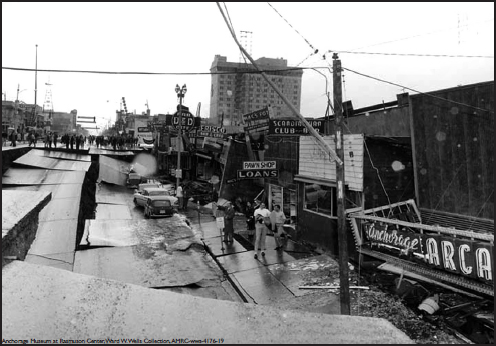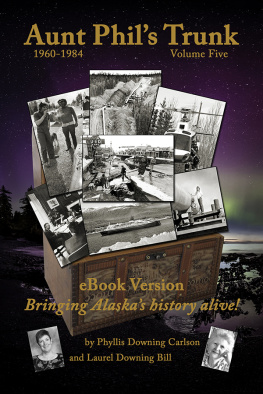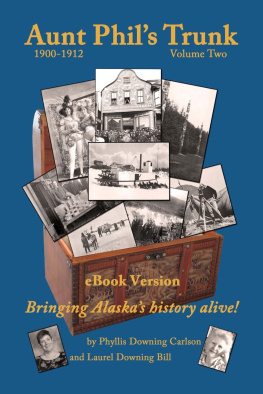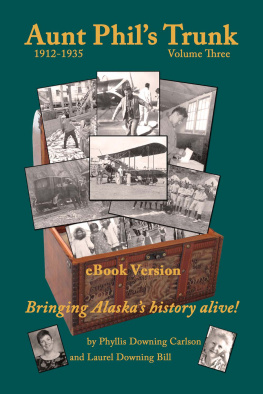Aunt Phils Trunk
Volume Five
Bringing Alaskas history alive!
By
Phyllis Downing Carlson
Laurel Downing Bill
Aunt Phils Trunk LLC
Anchorage, Alaska
www.auntphilstrunk.com
Cover photograph of the northern lights over Kodiak Island in May 2015 by Melissa Baines Graphic Design & Photography of Kodiak, Alaska.
Other front cover photo credits from top left: Street merchants, Alaska State Library, Pipeline Impact Collection, ASL-P17-9124; strings of pipe, Alaska State Library, Trans-Alaska Pipeline Construction Collection, ASL-P2-5-56; helicopter, Alaska State Troopers. Center photo, Anchorage Fourth Avenue earthquake, Alaska State Library, U.S. Army Signal Corps, ASL-P175-186. Lower left: Walter Hickel, Alaska State Library, Portrait File, ASL-P01-4686; MV Wickersham, Alaska State Library, Herbert J. Red Lockert Collection, ASL-P452-169; X-ray pipe weld, Alaska State Library, Pipeline Impact Collection, ASL-P17-8052.
Back cover photo credits from left: Oil platform Cook Inlet, Alaska State Library, Alaska Division of Tourism Collection, ASL-P22-06-069; Howard Rock, University of Alaska Fairbanks, Alfred R. Ketzler Collection, UAF-1992-202-9; Cowboys in Fairbanks, Alaska State Library, Pipeline Impact Collection, ASL-P17-8218.
Copyright 2016 by Laurel Downing Bill.
All rights reserved. No part of this book may be used or reproduced in any manner whatsoever without written permission from the author, except in the case of brief quotations embodied in critical articles and reviews.
International Standard Book Number 978-1-940479-04-0
Library of Congress Control Number 2016908361
Printed and bound in the United States of America.
First Printing
DEDICATION
I dedicate Volume Five to the memory of my paternal aunt, Phyllis Downing Carlson. She was one of Alaskas most respected historians, and without her lifelong interest, and then researching and writing about Alaska, this series would never exist.
I also want to dedicate the work to Aunt Phils stepchildren, grandchildren, great-grandchildren and their families; to my brothers and sisters, their families and all our cousins. And I dedicate the work to my husband, Donald; son Ryan and his wife, Kaboo; daughter Kim and her husband, Bruce Sherry; and daughter Amie and her husband, Toby Barnes. Thank you so much for believing in me.
Lastly, I dedicate this collection of historical stories to my grandchildren, Sophia Isobel and Maya Josephine Sherry; Aiden Kou Bill; and Toben Alexander, Conner Vincent and Zachary Victor Barnes. May you and future generations be the keepers of our history.
ACKNOWLEDGMENTS
I extend a heartfelt thank you to Robert DeBerry, formerly of Anchorage, for his excellent attention to detail as he readied for publication the majority of the historical photographs that appear in this volume of Aunt Phils Trunk. I also am grateful to Nancy Pounds of Anchorage for slaving away with her eagle eyes to carefully proofread the pages.
My family deserves medals, as well, for putting up with me as I chased down just the right photographs to go with the stories, poured through research and sat hunched over my computer for hours writing the stories that fill the pages of Aunt Phils Trunk Volume Five.
I love each and every one of you!
INTRODUCTION
The stories that fill this fifth volume of Aunt Phils Trunk pay homage to people, places and events that helped shape Alaskas first 25 years of statehood. While it does not cover every story of the era, it highlights some of the major and minor tales between 1959 and 1984.
Those early Alaska statehood years were a roller-coaster ride that took the infant state from the poorhouse to the penthouse. Oil discoveries on its North Slope brought riches beyond any of its residents dreams. Billions of barrels in black gold surpassed the golden riches clawed out of its creeks and mountains during the gold-rush era.
The new state traveled a rocky road on its journey from rags to riches. When it officially became a state on Jan. 3, 1959, it had a population of about 200,000 people. Its newly elected governor and legislature had to create a government to cover 586,412 square miles one-fifth the size of the entire Lower 48 from scratch, since the federal government had run the show since 1867, following Americas purchase of Alaska from the Russians. The United States designated the vast land a possession at that time, run at first by the War Department. It became a territory in 1912.
We were the only organized territory precluded by federal law from selection of any lands, from the management whatsoever of its natural resources, from creating a territory-wide judicial system, or a local government system, with the exception of the creation of certain first-class cities, said William A. Egan, Alaskas first elected governor, in an article for The Anchorage Times on Jan. 3, 1984. We had no voting rights in Congress, yet we paid all federal taxes.
Alaskans entered the new era with optimism, but they also knew they had a lot of work to do. They faced challenges in health care, housing, communications and an inflated cost of living. Howard Weaver, then managing editor of the Anchorage Daily News, described it best in a special publication titled The Flag Unfurled, dated Jan. 3, 1984, which highlighted Alaskas first 25 years of statehood.
children died because the best medical care was a seven-hour plane ride away in Seattle. The worrisome initials were TB, not PCB, and tuberculosis consumed Alaskans at a fierce rate. Village housing would have needed considerable improvement to deserve a sub-standard rating, and inflation and the cost of living regularly galloped past national rates. Long-distance communication was either expensive or absent.
In light of all the challenges facing Alaska, Weaver asked the question: Why do all those photos of early statehood days show so many smiling faces? He concluded what most Alaskans instinctively know living in Alaska may be challenging, but its fun.
The secret of Alaska is that verbs matter more than nouns, he wrote. It isnt the parade thats important, its the parading.
Which is why its not surprising to those who call Alaska home that the early movers and shakers of statehood jumped into the deep end of the pool and soon were attempting to better the lives of Alaskans. They built the infrastructure for self-governance, including creating a judicial system, a local government system and a land and resource management system. The Alaska Marine Highway System developed during this time, too. By early 1964, new ferries connected the people of Southeast Alaska and transformed their lives.
Alaskans accomplished much during the first five years of statehood. The next five brought the lowest of lows and the highest of highs to the fledgling state.
The lowest point occurred on March 27, 1964, at 5:36 p.m. The largest earthquake ever to hit the North American continent struck Southcentral Alaska with a jolt that measured 9.2 on the Moment Magnitude Scale and lasted nearly five minutes.
That Good Friday quake devastated communities from Prince William Sound to Kodiak Island, killing 114 people in Alaska. The seismic sea wave that fanned out into the Pacific killed another four people in Oregon and 12 in California.
Alaskas people were down but not out following this horrendous event, which caused $400 million in damage more than $3 billion in 2015 dollars. They rolled up their sleeves and dug in for the hard work of rebuilding their towns, roads and bridges. Federal aid helped ease some of the financial burden caused by so much destruction.

Next page










